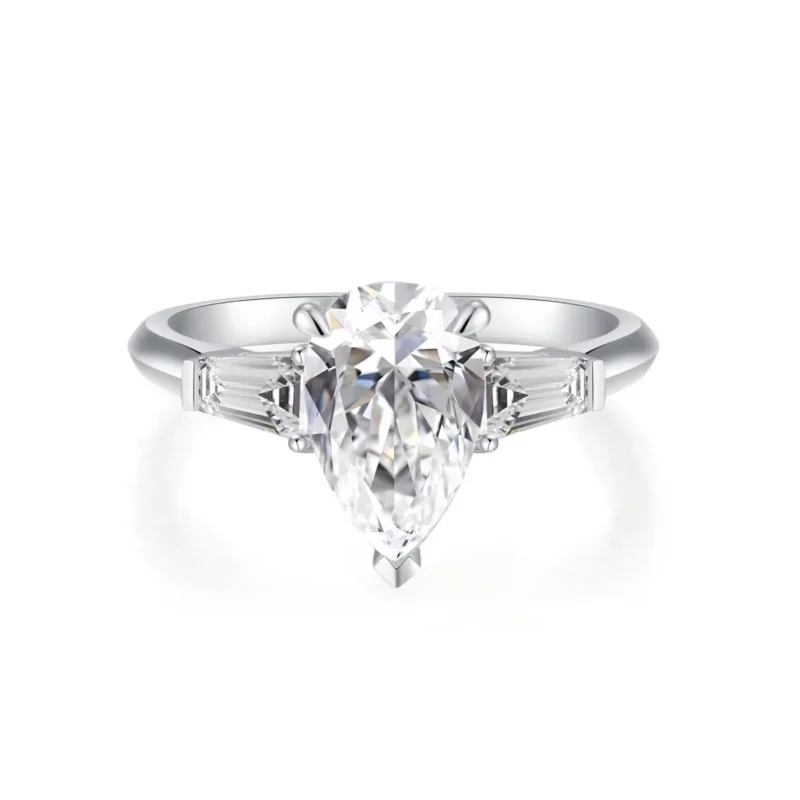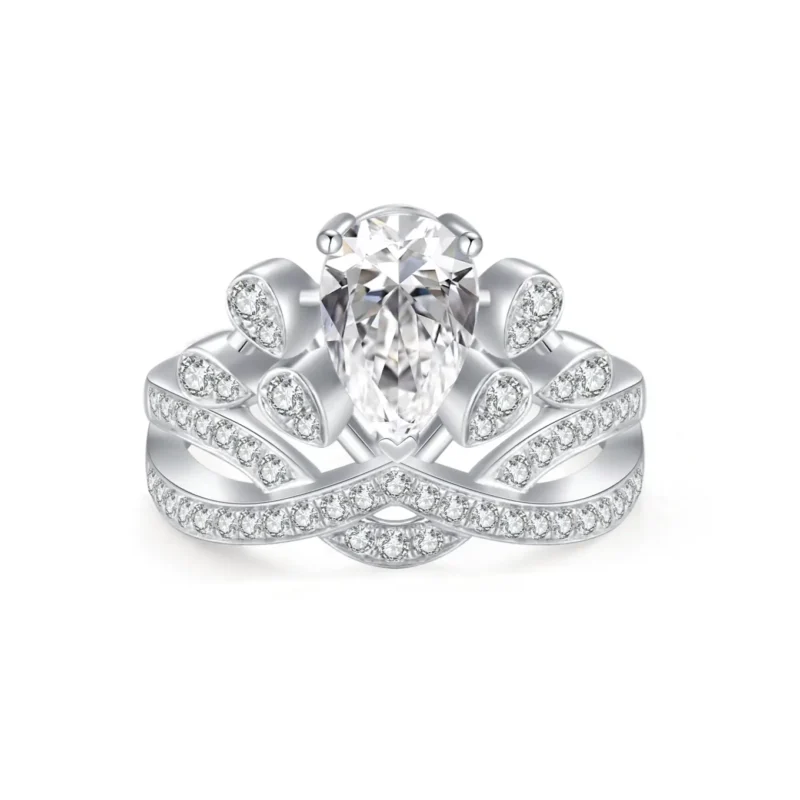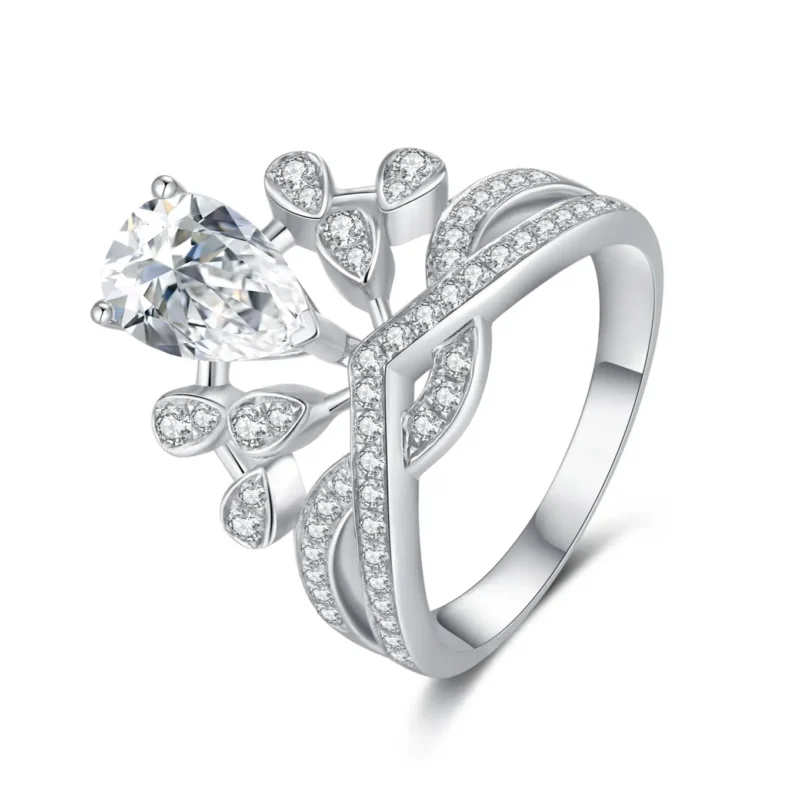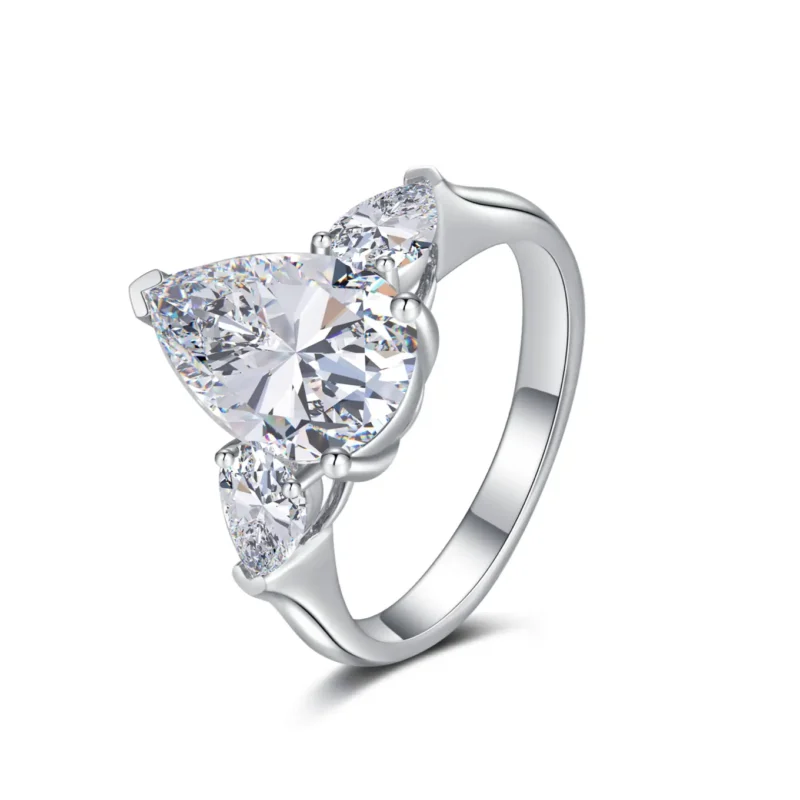Pear shape diamonds embody a teardrop silhouette, symbolizing elegance and eternal romance. Each curve dances with light in a display of delicate brilliance.
Free customized gift card
Lifetime resizing
Free engraving
Customized stone size
HELPFUL INSIGHTS
What is Pear Shape Diamonds
A pear shape diamond, affectionately dubbed the “teardrop of love,” is a mesmerizing hybrid of the fiery brilliance of a round cut and the bold elongation of a marquise. Its unique silhouette—rounded on one end and tapered to a delicate point on the other—creates a shape that’s equal parts romantic and daring. Born in the 18th century, this cut was a favorite of European royalty, symbolizing both opulence and emotional depth (think tears of joy or timeless love). Today, pear shapes are a modern classic, adored for their versatility. They shine as solitaire engagement rings, dangle elegantly in earrings, or become the centerpiece of a showstopping pendant.
But what makes lab-grown pear diamonds even more special? Advanced technology allows for flawless symmetry and precision cutting, eliminating common issues like uneven “wings” or dark bowtie effects. Lab-grown methods also ensure ethical sourcing—no mining, minimal environmental impact, and complete transparency. Plus, the elongated design creates an optical illusion: a 1-carat pear can look larger than a round diamond of the same weight! At GLARINS, every lab-grown pear diamond is hand-inspected for balance and sparkle, ensuring it’s not just a gem, but a storytelling piece. Whether you’re drawn to its vintage charm or its modern edge, the pear shape is a celebration of individuality.
Why Choose Pear Shape Diamonds
Pear shape diamonds aren’t just jewelry—they’re wearable magic. Here’s why they’re stealing hearts:
- Symbolism with Soul: The teardrop silhouette isn’t just pretty—it’s poetic. It’s been called a “teardrop of joy,” making it perfect for engagements, anniversaries, or celebrating new beginnings. Lab-grown pears add an ethical layer to this symbolism, letting your love story shine without environmental guilt.
- Flattery, Redefined: The elongated shape slims fingers and pairs beautifully with any hand shape. It’s like Spanx for your ring finger! For earrings or pendants, the taper draws the eye upward, creating a graceful, lengthening effect.
- Brilliance on a Budget: Lab-grown pear diamonds offer up to 40% savings compared to natural diamonds. This means you can splurge on a larger carat or higher clarity grade (hello, VS1!) without compromising sparkle.
- Durability Meets Design: Worried about the delicate tip? Modern settings like V-prongs or bezels protect the point, making pear shapes surprisingly practical for daily wear. Plus, lab-grown diamonds are just as durable as mined ones—they’re a 10 on the Mohs hardness scale!
- Style Chameleon: Pair a pear solitaire with a gold band for minimalist chic, or go bold with a halo of lab-grown melee diamonds. It’s the only shape that effortlessly bridges vintage romance and contemporary edge.
In short, pear shapes are for the rule-breakers, the romantics, and the eco-conscious. Why blend in when you can drip in symbolism and sparkle?
Pear Shape Diamonds VS Other Shapes
Let’s settle the diamond shape debate once and for all. Here’s how lab-grown pear diamonds outshine the rest:
vs. Round Brilliant:
Round cuts are timeless, but they’re also the most common (and pricey!). Lab-grown pears deliver the same scintillation but with a unique profile that stands out. Plus, their elongation makes them appear larger per carat—ideal for maximizing your budget.
vs. Princess Cut:
Princess cuts are angular and modern, but their sharp corners snag on fabrics and require bulky settings. Pear shapes offer soft curves that glide through life, whether you’re typing, gardening, or swiping right on your next date.
vs. Oval:
Ovals are trendy, but their symmetrical shape can sometimes look “flat.” Pear’s tapered point adds dimension and movement, catching light from every angle. Lab-grown technology ensures the tip is perfectly proportioned, avoiding the “too pointy” worry.
vs. Marquise:
Marquise diamonds share the pear’s elongation, but their two sharp ends are prone to chipping. Pear shapes solve this with one rounded lobe, making them safer for active lifestyles.
Why Lab-Grown Pears Win:
Ethical Edge: Zero mining, smaller carbon footprint, and guaranteed conflict-free origins.
Precision Perfection: Lab cutting eliminates natural flaws, ensuring every facet aligns for maximum fire.
Cost Efficiency: Save big without sacrificing size or quality—put those savings toward a custom setting!
If you want a diamond that’s as bold, ethical, and unforgettable as you are, pear shapes are the clear winner.
How to Choose the Best
Let’s turn you into a pear diamond pro—no jargon, just juicy tips!
Step 1: Fall in Love with the Cut
The cut is the soul of your diamond. For pears, symmetry is non-negotiable. Ask for a magnified view: the two halves should mirror each other, and the tip should align with the rounded lobe’s center. Avoid stones with a visible “bowtie” (a dark shadow across the middle)—this means uneven light return. Lab-grown diamonds often excel here, as their controlled environment allows for near-perfect cuts.
Step 2: Play the Color & Clarity Game
Color: Stick to G-H grades. The tapered tip hides faint yellow tints, so you save money without sacrificing icy white brilliance.
Clarity: VS2 or SI1 is your sweet spot. Lab-grown pears have fewer inclusions than mined ones, so even SI1 stones often look flawless to the naked eye.
Step 3: Size Strategically
Love the “wow” factor? A 1.5-carat lab-grown pear looks like a 2-carat round! On a budget? A 0.75-carat stone in a halo setting still stuns.
Step 4: Armor Up the Tip
The point is delicate, but these settings keep it safe:
V-Prong: Wraps the tip like a hug.
Bezel: Encases the diamond in metal—sleek and secure.
Halo: Surrounds it with tiny diamonds for protection + extra bling.
Step 5: Trust the Paperwork
Only buy GIA or IGI-certified lab-grown diamonds. These reports detail cut, color, and clarity—no guesswork!
Step 6: Listen to Your Gut
Try it on. Does it make your heart race? Does it suit your daily life? If you’re a yoga instructor, maybe skip the sky-high cathedral setting.
With these steps, you’re not just buying a diamond—you’re crafting a legacy. Go forth and sparkle, wisely!
FAQ
Are pear diamonds more expensive than round ones?
Often less costly per carat, but intricate cuts may raise prices slightly.
Do pear shapes snag on clothing?
A secure setting (like a V-prong) prevents snagging—great for active lifestyles.
How do I clean my pear diamond jewelry?
Soak in warm soapy water, gently brush with a soft toothbrush, and rinse.
Are pear diamonds good for engagement rings?
Absolutely! They’re durable (when set properly) and symbolize timeless love.
Do pear shapes look bigger than round diamonds?
Yes! Their elongation creates a larger surface area per carat.












